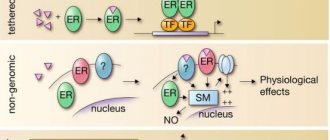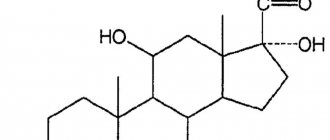Blood test for hormones
used in modern medicine to assess the health of the human body. Hormones are active biological substances with different chemical structures that influence many internal and external processes in the body. A blood test for hormones allows you to identify hormonal imbalances in the body, determine the cause of the disease and create the correct course of treatment. Hormone analysis is used in gynecology, urology, endocrinology, andrology, oncology, neuropathology, gastroenterology, as well as by doctors of other specialties.
A blood test for hormones is prescribed if there is a suspicion of dysfunction of the hormonal glands or if there is a clear increase in their size. This examination is also prescribed during pregnancy in case of suspected pathological development of the fetus.
Blood test for hormones when planning pregnancy
When planning a pregnancy, it is very important to take a blood test for hormones. Timely completion of the analysis will avoid many possible problems in the future.
The main hormones tested using a hormone blood test when planning a pregnancy are listed below:
FSH (follicle stimulating hormone)
– in women, is responsible for the growth of the egg (follicle) in the ovary. In men, it is one of the main sex hormones that regulate reproductive function.
LH (luteinizing hormone)
– in women, it ensures the completion of maturation of the egg in the follicle and subsequent ovulation (rupture of the follicle and release of the egg). In men, it affects the maturation of sperm.
Prolactin
– stimulates lactation after childbirth. During pregnancy, it reduces the release of FSH. If there is no pregnancy, an increased amount of prolactin can lead to a pathological deficiency of FSH and prevent conception.
Estradiol
– affects all female genital organs.
Progesterone (pregnancy hormone) is produced after the egg matures. Without this hormone, a fertilized egg cannot attach to the uterus. Lack of progesterone can cause miscarriage.
Testosterone
is a male sex hormone; an increased amount of testosterone in women can lead to miscarriage, and a decreased amount in men can lead to a decrease in sperm quality.
DEA-sulfate (DEA-s or DEAS)
– produced in small quantities in the body of women. Increased concentrations of this hormone can lead to infertility.
Thyroid hormones
. Thyroid dysfunction can also cause infertility.
Blood taken from a vein is used to test blood for hormones. To get a detailed picture of the patient’s health status, it is necessary to take a test for the hormones of the following glands.
Sign up for a blood test for hormones
Make an appointment
What it is
In men, androgens work as natural anabolics: they stimulate the formation of protein in muscle tissue, increase basal metabolism and accelerate the formation of red blood cells in the red bone marrow. If there are enough androgens, a male body type with broad shoulders and narrow hips is formed, and the male genital organs fully develop and function.
In women, androgens also take part in puberty. They are responsible for hair growth in the armpits and pubic area, promote sebum production, strengthen bones and, apparently, increase libido. Testosterone is also a precursor to the most important female sex hormone, estradiol, so the level of this androgen indirectly affects female fertility.
Pituitary hormones
TSH (thyroid stimulating hormone)
– stimulates the production of thyroid hormones (T3 and T4). Normal values: 0.4-4.0 mU/l. An elevated TSH value usually indicates decreased thyroid function.
FSH (follicle stimulating hormone)
. Normal values: in women - depends on the phase of the menstrual cycle. Phase I – 3.35-21.63 mU/ml; Phase II – 1.11-13.99 mU/ml; postmenopause – 2.58-150.53 mU/ml; girls under 9 years old 0.2-4.2 mU/ml. In men – 1.37-13.58 mU/ml.
LH (luteinizing hormone)
. Normal values: in women - depends on the phase of the menstrual cycle. Phase I – 2.57-26.53 mU/ml; Phase II – 0.67-23.57 mU/ml; postmenopause – 11.3-40 mU/ml; girls under 9 years old - 0.03-3.9 mU/ml. In men – 1.26-10.05 mU/ml.
Prolactin
. The main function is to stimulate the development of mammary glands and lactation. Normal values: in women (from the first menstruation to menopause) – 1.2-29.93 ng/ml; in men – 2.58-18.12 ng/ml. An increased concentration of prolactin in women leads to menstrual irregularities and may cause infertility. In men, hyperprolactinemia leads to decreased libido and impotence.
ACTH
(adrenocorticotropic hormone) - stimulates the synthesis and secretion of hormones from the adrenal cortex. Normal values: 9-52 pg/ml.
Why is it prescribed to men?
There are five androgens in the male body. These are androstenedione, testosterone, dihydrotestosterone (DHT), dehydroepiandrosterone (DHEA) and dehydroepiandrosterone sulfate (DHEA-S.
In men, all forms of androgens, except DHT, are synthesized in the testes. DHT, the most active version of testosterone, is produced only in the tissues of internal organs. A small amount of androstenedione, DHEA and DHEA-S are formed in the adrenal cortex and normally do not play an important biological role.
Normal levels of androgens in the blood in men:
| Testosterone | DHT | DEA | DEA-S |
| 0.2-1.0 ng/ml | 14-77 ng/dL, rarely determined because the analysis does not reflect the intracellular concentration of the hormone | 0.9-6.0 µg/l | 2800-6400 µg/l |
“As a rule, urologists-andrologists ask the patient to take tests for androgens when the patient is concerned about the symptoms of so-called hypogonadism. This problem is usually faced by men after 45-50 years of age, whose libido and endurance decrease, and their general tone deteriorates, says Konstantin Lokshin, head of the center for operative urology, oncourology and andrology at GMS Clinic. “The urologist will be interested in testosterone levels, but sometimes an additional test for sex hormone binding globulin (SHBG) may be required.”
In addition, sometimes tests for androgens are prescribed for delayed or, conversely, premature puberty, suspected tumor and problems with potency. With these problems, the testes and adrenal glands may produce too much or, conversely, too little androgens.
The level of testosterone in the blood increases with tumors of the testes and adrenal glands. In the first case, the testes create more testosterone than necessary, and this is reflected in the test results. In the second case, the adrenal glands create too much androsterone, the excess of which is converted into testosterone - and this also affects the result.
The level of testosterone in the blood decreases when the testes are malfunctioning. There can be many reasons: from congenital genetic diseases and injuries received in adulthood to infectious diseases, severe stress or excessive physical exertion. Sometimes this leads to loss of muscle mass, decreased libido and gynecomastia - female-type breast enlargement.
The level of DHEA and DHEA-S in the blood increases with male infertility associated with hyperplasia, that is, with excessive growth of the adrenal glands. In adult men, excess adrenal androgens can suppress gonadal function and cause delayed sexual development or infertility.
Levels of DHEA and DHEA-S in the blood may decrease in Addison's disease, a condition in which the adrenal glands fail to produce enough androgens, and in hypopituitarism, a condition in which the pituitary gland does not produce enough hormones that stimulate the adrenal glands. In men, this may cause a decrease in libido, erectile dysfunction or infertility.
Adrenal hormones
DEA-s (dehydroepiandrosterone sulfate)
– necessary for the synthesis of testosterone and estrogens. The normal range for the concentration of this hormone is: 3591-11907 nmol/l; in women – 810-8991 nmol/l. However, this is the general picture; when processing analysis data, the patient’s age must also be taken into account.
Cortisol
– participates in many metabolic processes, is actively produced as a result of the body’s response to hunger or stress. Normal values: for children under 16 years of age - 3-21 mcg/dl, for an adult - 3.7-19.4 mcg/dl.
Aldosterone
– responsible for regulating water-salt balance in the body. Normal values: 35 - 350 pg/ml.
What can they say?
Androgens work in almost all organs and tissues, so they have a noticeable effect on the entire body. Deviation of androgen levels from the norm may indicate health problems. To determine the cause of these problems and clarify the diagnosis, doctors may order appropriate tests.
It is difficult to understand their results on your own. Both an increase and decrease in the level of male sex hormones can indicate different conditions and diseases. In order to correctly interpret the analysis, it is necessary to take into account the person’s complaints, features of the physical structure, and sometimes additional tests and examinations may be required. Therefore, you need to draw conclusions together with your doctor.
Preparing for a blood test for hormones
A blood test for hormones uses data obtained from venous blood. Blood is drawn from a peripheral vein (ulnar or radial vein in the area of the elbow joint). Before blood collection, the puncture site is treated with an antiseptic.
It is worth noting that the patient should properly prepare for a blood test for hormones
:
- 8-10 hours before the procedure, you should not eat food or drink drinks containing sugar.
- You should refrain from drinking alcohol 2-3 days before the procedure.
- On the day of blood sampling, avoid physical and emotional stress.
- The test should be taken before taking medications or diagnostic treatment procedures.
- Women are recommended to get tested on days 5-7 of their cycle. A week before the test, stop taking hormonal medications.
The final analysis is deciphered by your attending physician.
Sign up for a blood test for hormones
Make an appointment
Why are hormones important?
A lack of hormones in the body leads to serious diseases such as diabetes. Due to disruption of the hormonal system, people can be born dwarfs; women can have problems with pregnancy, the menstrual cycle, excess weight, increased hair growth, acne on the face, and premature ovarian failure.
Based on what complaints the patient receives, the doctor determines which hormones the woman should be tested for.
What tests are done for thyroid hormones?
- TSH (more fully known as thyroid-stimulating hormone, or thyropine) is a substance produced by the pituitary gland. It activates the formation and production of hormones in the thyroid gland (such as T3 and T4). When the functioning of the pituitary gland is not impaired, the TSH level decreases against the background of increased thyroid function, and increases against the background of weakened thyroid function.
- Free T3 (another name is free triiodothyronine) is a substance synthesized by the thyroid gland that stimulates metabolic processes and activates oxygen uptake in tissues.
- Free T4 (we are talking about free thyroxine) is a hormonal substance produced by the thyroid gland and activates the processes of protein synthesis.
- AT-TG (meaning the presence of antibodies to thyroglobulin) - the level of these antibodies makes it possible to detect autoimmune pathologies of the thyroid gland, such as Hashimoto's disease, diffuse toxic goiter, atrophic autoimmune thyroiditis.
- AT-TPO (presence of microsomal antibodies, or antibodies to thyroid peroxidase) - we are talking about the presence of antibodies to the enzyme substance of gland cells. This analysis is very important for diagnosing autoimmune pathologies.
Antibodies
Many patients want to clarify: why does the analysis of thyroid hormones contain information not only about the hormones themselves, but also about some unknown antibodies? Why does a doctor need information about the so-called AT-TPO and AT-TG?
The fact is that an increase in the concentration of the antibodies presented indicates the presence of certain autoimmune processes in the gland. Such an analysis is not performed without indications: it is prescribed if the fact of autoimmune pathology has already been proven.
For the patient, changes in antibody levels are, in principle, unlikely to be informative. After all, the increase in the level of AT-TPO and AT-TG is not considered individually, but in combination with other indicative changes. Thus, an increase in their content against the background of a normal TSH value does not indicate the presence of pathology.
How is a thyroid hormone test taken?
The material is collected as follows:
- The health worker prepares instruments, laboratory directions (labels, enters information about the patient, makes notes in the journal and/or electronic system).
- The patient sits down on a chair. The health worker fixes his arm, first turning his palm up and extending the elbow joint as much as possible. For convenience, a special cushion is placed under the elbow area.
- Apply a tourniquet to the area of the middle third of the shoulder (pulse impulses on the wrist should be palpable).
- The specialist treats the skin in the area of the elbow with alcohol, asks the patient to make several movements, clenching and unclenching his fist (this will allow the vein to be filled to the maximum with blood), after which the patient fixes the fist in a clenched state.
- The healthcare worker punctures the vein (an acute angle must be maintained) and draws material into a test tube or special system, while simultaneously loosening the tourniquet. At this time, the patient loosens his fist.
- The specialist applies a cotton pad moistened with alcohol to the puncture site and removes the needle from the vessel. If a vacuum system was used, the tube with blood is first disconnected.
- The patient should sit for a while with his arm bent at the elbow joint to avoid bleeding. Usually 5-6 minutes are enough for this.
The health worker places the signed test tubes in a special container and then sends them to the laboratory.
Hormone tests after thyroid removal
After surgery to completely remove the thyroid gland (this intervention is called a thyroidectomy), the production of thyroid-stimulating hormones completely stops. As a result, the pituitary gland begins to work at an accelerated pace, trying to replenish adequate hormonal levels. At this stage, it is very important to start taking thyroxine so that complications such as thyroid coma do not develop. The first symptoms of this condition may be:
- apathy, constant drowsiness, clouding of consciousness;
- decreased body temperature;
- attacks of cold sweating;
- bradycardia, muscle atony;
- memory impairment;
- problems with kidney function;
- decreased intestinal motility.
The stated symptoms do not appear immediately, but gradually. Therefore, taking thyroxine after surgery is mandatory. Periodically, the patient must take a blood test to check the TSH level.
A low TSH level after removal of the thyroid gland may indicate taking excessively high doses of thyroxine, or a functional failure of the pituitary-hypothalamus system in the brain.
A high TSH level after thyroidectomy indicates excessive production of TSH - for example, in disorders of endocrine function, during treatment with certain drugs (antiemetics, antiepileptics, prednisolone, cardiac glycosides, morphine-containing drugs, oral contraceptives).









